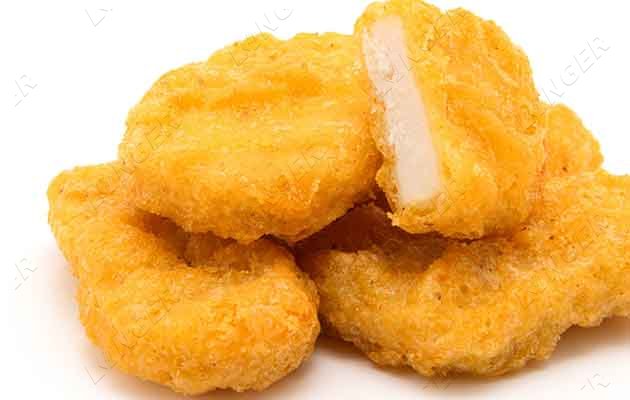Chicken nuggets are a popular fried food, beloved by consumers for their crispy skin and tender meat. So, how are chicken nuggets produced? From raw materials to finished product, chicken nugget production may seem simple, but it actually involves multiple rigorous processes, each of which directly impacts the product's taste and quality.
How are chicken nuggets produced?
1. Raw Material Preparation
The primary raw material for chicken nuggets is chicken breast or thigh meat. First, the raw chicken is inspected to ensure it is free of odor, impurities, and spoilage. It is then deboned, skinned, and trimmed into chunks or slices for further processing. Some products may incorporate some plant protein or seasoning to improve taste or reduce costs.
2. Mincing and Seasoning
According to the recipe, the chicken is ground into a fine, defined mince. Salt, starch, protein powder, spices, and seasonings are then added and thoroughly blended in a blender. This step determines the texture and flavor of the chicken. The blending time and speed must be carefully controlled to ensure a smooth blend without disrupting the meat's fiber structure.
3. Forming
The seasoned chicken mince is fed into a forming machine, where it is pressed into uniform nuggets, such as round, oval, or other shapes. The automatic forming machine ensures consistent appearance, accurate weight, and uniform thickness.
4. Coating with batter
After forming, chicken nuggets undergo a series of steps: coating with batter, coating with batter, and coating with batter again to create a crispy coating. The outer coating is typically a mixture of wheat flour, cornstarch, and breadcrumbs, while the batter contains egg, seasoning, and other ingredients. This process determines the color and texture of the chicken nuggets after frying.
5. Pre-frying
After coating the chicken, it's briefly "pre-fried" in a deep fryer, typically at a temperature between 160°C and 180°C for 30 to 60 seconds. This isn't a complete deep-fry, but rather serves to firm the chicken's shape, create a preliminary golden crust, and lock in moisture.
6. Quick Freezing
After pre-frying, the chicken nuggets are quickly placed in a quick freezer, typically at a temperature of -35°C to -40°C. This process rapidly passes through the food's ice crystal formation zone, preserving the chicken's tenderness and nutritional value to the greatest extent possible.
 Issues to Note During Production
Issues to Note During Production
Although the chicken nugget production process is simple, every step requires strict control to ensure the quality of the finished product.
Ingredient Hygiene and Freshness: Using fresh chicken is essential for ensuring both taste and safety.
Precise Seasoning Ratio: Seasonings must be added accurately to prevent uneven flavor or over-marinating.
Molding Temperature Control: Excessively high minced meat temperature can cause water release and difficulty molding. Maintain a temperature between 0°C and 4°C.
Frying Temperature and Time: Excessively high oil temperatures can result in burnt exteriors and undercooked interiors, while excessively low temperatures can lead to excessive oil absorption. An automatic fryer should be used for constant temperature control.
Preventing Cross-Contamination: Raw and cooked food must be separated, and equipment and workers must adhere to strict hygiene protocols.
From raw material preparation to finished product, chicken nuggets are produced on a highly automated, strictly controlled modern
chicken nugget production line. Only by maintaining precise control of hygiene, temperature, time, and proportions at every stage can we ensure crispy chicken nuggets, tender inside, consistent flavor, and safety.

